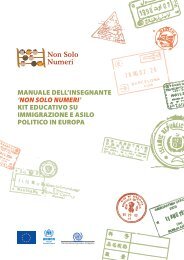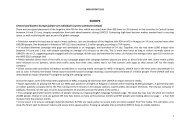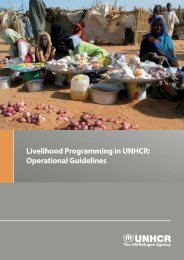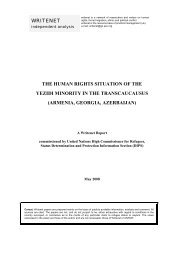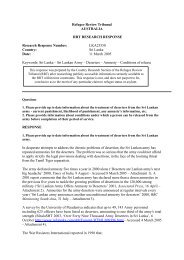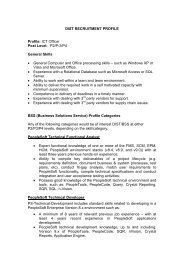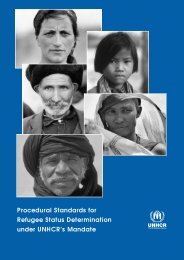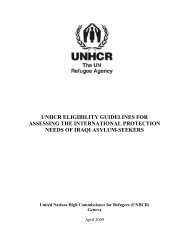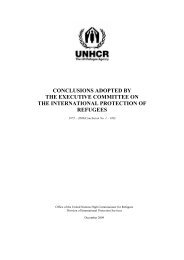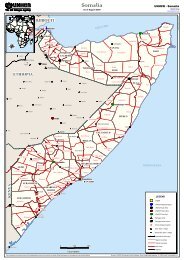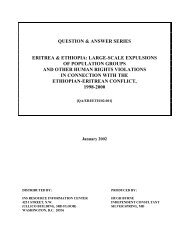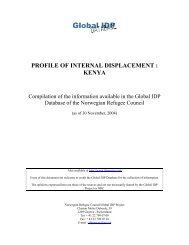UNHCR's ELIGIBILITY GUIDELINES FOR ASSESSING THE ...
UNHCR's ELIGIBILITY GUIDELINES FOR ASSESSING THE ...
UNHCR's ELIGIBILITY GUIDELINES FOR ASSESSING THE ...
You also want an ePaper? Increase the reach of your titles
YUMPU automatically turns print PDFs into web optimized ePapers that Google loves.
focused on Islamic artifacts. 255 The predominantly Christian area of Camp Sara in central<br />
Baghdad has repeatedly come under attack, including by mortar fire and car bombs,<br />
causing a number of casualties. 256<br />
The situation further worsened with the onset of controversy regarding cartoons of the<br />
Prophet Mohammed 257 and the speech made by Pope Benedict XVI on 12 September 2006<br />
that included the quotation of a 14 th Century Byzantine emperor that outraged segments of<br />
the Muslim community worldwide and triggered protests and even attacks on churches in<br />
several Muslim countries. 258 In February 2006, Iraqi Christian students at Mosul University<br />
were attacked by other students who described the Christian students as atheists and US<br />
traitors. The attacks may have been motivated by fatwas and militia statements calling on<br />
Iraqis to expel Christians and atheists from schools, institutions and the streets of Iraq<br />
because they offended the Prophet. Following these attacks, one Christian female student at<br />
Mosul University was reportedly killed while awaiting transportation. 259 Christian students<br />
in Mosul face a climate of extreme insecurity, and UNHCR has received reports that<br />
Christian students have sharply curtailed their class attendance and strictly avoid moving<br />
alone. IRIN reported that Christian parents have stopped their children from attending<br />
schools and universities, after many fellow students made verbal threats against them. 260<br />
Hundreds of angry demonstrators burned an effigy of the Pope in the southern city of<br />
Basrah, angered that the Pope’s speech had insulted Islam, and called for him to be tried by<br />
255<br />
BBC News, Leading Iraq archaeologist flees, 26 August 2006, http://news.bbc.co.uk/2/hi/middle_east/<br />
5289046.stm.<br />
256<br />
For example, on 14 February 2007, a car bomb near a hospital killed four people and wounded 10 others;<br />
see: Reuters Alertnet, Factbox – Security developments in Iraq, Feb 14, 14 February 2007,<br />
http://www.reuters.com/article/latestCrisis/idUSL14532109. On 4 October 2006, a car bomb and two roadside<br />
bombs killed 16 persons and injured at least 72; see: AP, String of bomb blasts in Baghdad kills 13, 4 October<br />
2006, http://www.usatoday.com/news/world/2006-10-04-baghdad-blasts_x.htm.<br />
257<br />
According to reports in Iraqi and international media, numerous Christian institutions in Iraq were<br />
targeted in reprisal attacks during the “cartoon controversy”. Iraqi sources linked the bombings of seven<br />
churches in Kirkuk, Baghdad and Mosul on 29 January 2006 to the protest campaigns. These attacks led to an<br />
increase in flight to Jordan and Syria; see IRIN, Iraq: Sectarian tensions on the rise, 30 January 2006,<br />
http://www.irinnews.org/Report.aspx?ReportId=26094; Elaph News (in Arabic), Bombing of Iraqi Churches<br />
Linked to Danish Cartoons, 29 January 2006, http://www.elaph.com/ElaphWeb/Politics/2006/1/124132.htm.<br />
258<br />
The “cartoons controversy” began after editorial cartoons depicting the Muslim Prophet Mohammed,<br />
were published in the Danish newspaper Jyllands-Posten on 30 September 2005. The newspaper announced<br />
that this publication was an attempt to contribute to the debate regarding criticism of Islam and selfcensorship.<br />
The controversy deepened when further examples of the cartoons were reprinted in newspapers in<br />
more than fifty other countries. This led to numerous protests, including violent rioting particularly in the<br />
Muslim world. See, for example, The Washington Post, The Mohammed Cartoon Controversy,<br />
http://www.washingtonpost.com/wp-dyn/content/linkset/2006/02/07/LI2006020701366.html [last updated<br />
7 January 2007]. The Pope Benedict XVI controversy arose from a lecture delivered on 12 September 2006<br />
by Pope Benedict XVI at the University of Regensburg in Germany. He explored the historical and<br />
philosophical differences between Islam and Christianity and the relationship between violence and faith. His<br />
quote from Emperor Manuel II Paleologos of the Orthodox Christian Byzantine Empire, who said the Prophet<br />
Mohammed had brought the world only “evil and inhuman” things, stood at the centre of the controversy.<br />
See, for example, Reuters / The New York Times, Pope apologizes after fury over Islam remarks,<br />
17 September 2006, http://www.iht.com/articles/2006/09/17/news/apology.php.<br />
259<br />
Information received by UNHCR.<br />
260<br />
IRIN, Iraq: Christians live in fear of death squads, see above footnote 228.<br />
62



